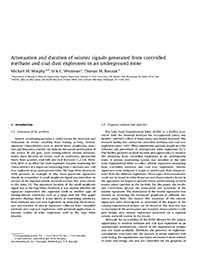Mining Publication: Attenuation and duration of seismic signals generated from controlled methane and coal dust explosions in an underground mine
Original creation date: December 2013
Seismic monitoring provides a useful means for detection and evaluation of events resulting from mining activity. Seismic signature characteristics such as arrival times, amplitudes, duration and frequency content can indicate the nature and location of the source. In the past, most mining-related seismic measurements have focused on events such as rockbursts, production blasts from quarries, roof falls and rock fractures [1,2,3,4]. However, little or no effort has been expended towards examining the characteristics of a signature emanating from a methane and coal dust explosion in an underground mine. The Sago Mine disaster in 2006 provides an example of why these particular signatures should be researched. A small amplitude signal was identified on records of the regional seismic network stations that were closest to the mine [5]. The epicentral location of the small amplitude signal was at the Sago Mine. However, it was unclear whether the signature represented the explosion itself or another type of mining-related seismicity such as a large roof fall. This paper presents findings from a study aimed at examining seismicity from methane and coal dust explosions by analyzing the attenuation and duration of seismic signatures collected from controlled methane and coal dust explosions, with potential applications to forensic studies of mine explosions such as the Sago Mine disaster.
Authors: MM Murphy, EC Westman, TM Barczak
Peer Reviewed Journal Article - December 2013
NIOSHTIC2 Number: 20041815
Int J Rock Mech Min Sci 2012 Dec; 56(5):112-120
See Also
- Analysis of Seismic Signatures from Gas and Dust Based Explosions at the Lake Lynn Experimental Mine
- Coal Dust Explosibility
- Coal-Dust Explosion Tests in the Experimental Mine 1919 to 1924, Inclusive
- Evaluation of the Bagged Stone Dust Barrier Effectiveness in a Bord and Pillar Mine
- The Explosibility of Coal Dust
- Historical Development of Technologies for Controlling Methane in Underground Coal Mines
- Mitigating Coal Dust Explosions in Modern Underground Coal Mines
- Observations of Post-Explosion Dust Samples From an Experimental Mine
- Rock Dusting Considerations in Underground Coal Mines
- Technology News 515 - Float Coal Dust Explosion Hazards
- Content source: National Institute for Occupational Safety and Health, Mining Program


 ShareCompartir
ShareCompartir
